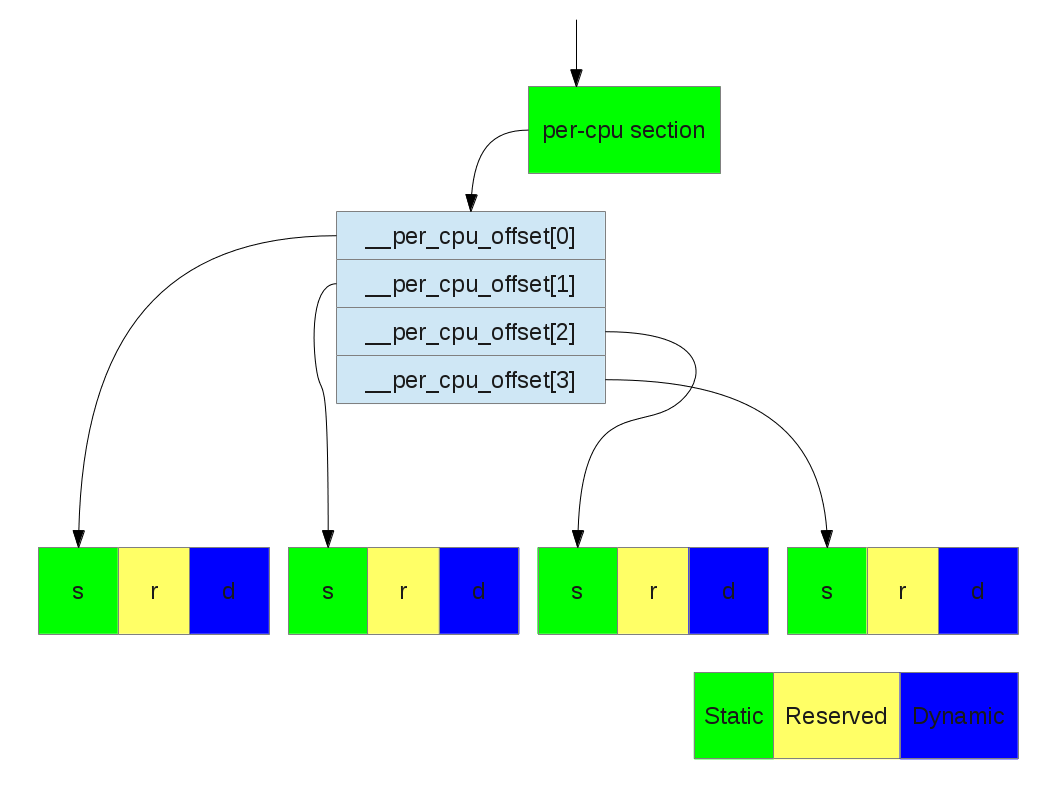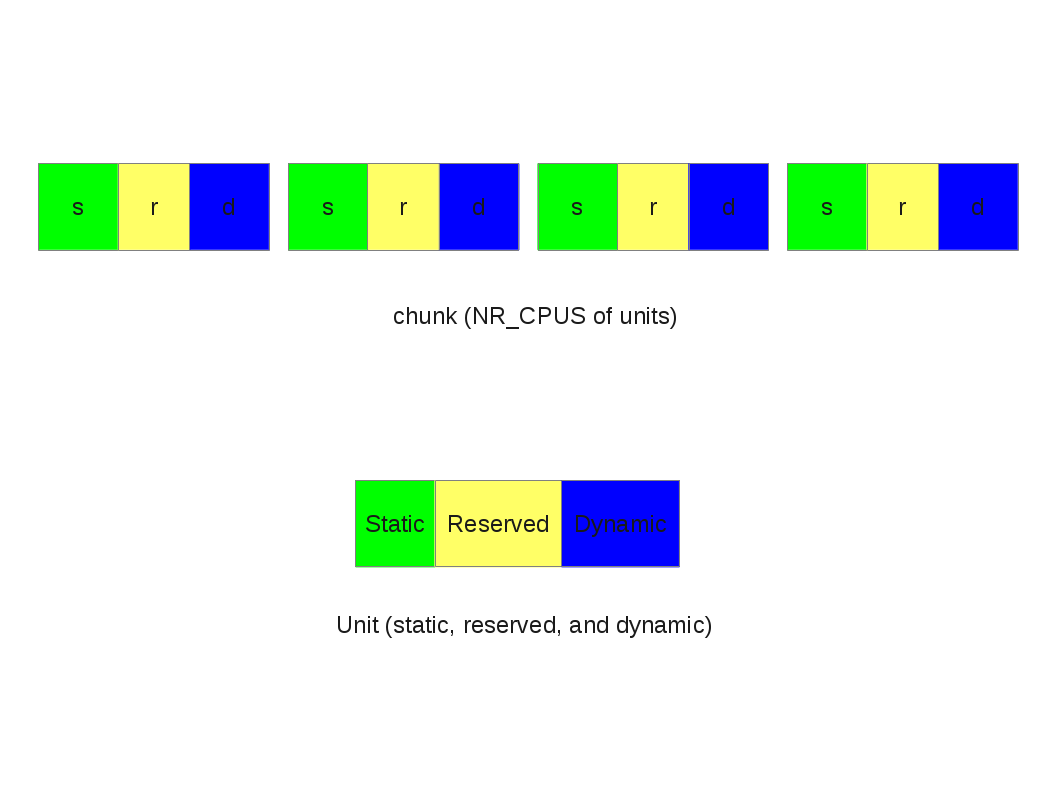A brief introduction to per-cpu variables
墙外通道:http://thinkiii.blogspot.com/2014/05/a-brief-introduction-to-per-cpu.html
per-cpu variables are widely used in Linux kernel such as per-cpu counters, per-cpu cache. The advantages of per-cpu variables are obvious: for a per-cpu data, we do not need locks to synchronize with other cpus. Without locks, we can gain more performance.
There are two kinds of type of per-cpu variables: static and dynamic. For static variables are defined in build time. Linux provides a DEFINE_PER_CPU macro to defines this per-cpu variables.
#define DEFINE_PER_CPU(type, name) static DEFINE_PER_CPU(struct delayed_work, vmstat_work);
Dynamic per-cpu variables can be obtained in run-time by __alloc_percpu API. __alloca_percpu returns the per-cpu address of the variable.
void __percpu *__alloc_percpu(size_t size, size_t align)
s->cpu_slab = __alloc_percpu(sizeof(struct kmem_cache_cpu), * sizeof(void *));
One big difference between per-cpu variable and other variable is that we must use per-cpu variable macros to access the real per-cpu variable for a given cpu. Accessing per-cpu variables without through these macros is a bug in Linux kernel programming. We will see the reason later.
Here are two examples of accessing per-cpu variables:
struct vm_event_state *this = &per_cpu(vm_event_states, cpu); struct kmem_cache_cpu *c = per_cpu_ptr(s->cpu_slab, cpu);
Let's take a closer look at the behaviour of Linux per-cpu variables. After we define our static per-cpu variables, the complier will collect all static per-cpu variables to the per-cpu sections. We can see them by 'readelf' or 'nm' tools:
D __per_cpu_start
...
000000000000f1c0 d lru_add_drain_work
000000000000f1e0 D vm_event_states
000000000000f420 d vmstat_work
000000000000f4a0 d vmap_block_queue
000000000000f4c0 d vfree_deferred
000000000000f4f0 d memory_failure_cpu
...
0000000000013ac0 D __per_cpu_end
[] .vvar PROGBITS ffffffff81698000
00000000000000f0 WA
[] .data..percpu PROGBITS 00a00000
0000000000013ac0 WA
[] .init.text PROGBITS ffffffff816ad000 00aad000
000000000003fa21 AX
You can see our vmstat_work is at 0xf420, which is within __per_cpu_start and __per_cpu_end. The two special symbols (__per_cpu_start and __per_cpu_end) mark the start and end address of the per-cpu section.
One simple question: there are only one entry of vmstat_work in the per-cpu section, but we should have NR_CPUS entries of it. Where are all other vmstat_work entries?
Actually the per-cpu section is just a roadmap of all per-cpu variables. The real body of every per-cpu variable is allocated in a per-cpu chunk at runt-time. Linux make NR_CPUS copies of static/dynamic varables. To get to those real bodies of per-cpu variables, we use per_cpu or per_cpu_ptr macros.
What per_cpu and per_cpu_ptr do is to add a offset (named __per_cpu_offset) to the given address to reach the read body of the per-cpu variable.
#define per_cpu(var, cpu) \
(*SHIFT_PERCPU_PTR(&(var), per_cpu_offset(cpu))) #define per_cpu_offset(x) (__per_cpu_offset[x])
It's easier to understand the idea by a picture:

Translating a per-cpu variable to its real body (NR_CPUS = 4)
Take a closer look:
There are three part of an unit: static, reserved, and dynamic.
static: the static per-cpu variables. (__per_cpu_end - __per_cpu_start)
reserved: per-cpu slot reserved for kernel modules
dynamic: slots for dynamic allocation (__alloc_percpu)

Unit and chunk
static struct pcpu_alloc_info * __init pcpu_build_alloc_info(
size_t reserved_size, size_t dyn_size,
size_t atom_size,
pcpu_fc_cpu_distance_fn_t cpu_distance_fn)
{
static int group_map[NR_CPUS] __initdata;
static int group_cnt[NR_CPUS] __initdata;
const size_t static_size = __per_cpu_end - __per_cpu_start;
+-- lines: int nr_groups = , nr_units = ;----------------------
/* calculate size_sum and ensure dyn_size is enough for early alloc */
size_sum = PFN_ALIGN(static_size + reserved_size +
max_t(size_t, dyn_size, PERCPU_DYNAMIC_EARLY_SIZE));
dyn_size = size_sum - static_size - reserved_size;
+-- lines: Determine min_unit_size, alloc_size and max_upa such that--
}
After determining the size of the unit, the chunk is allocated by the memblock APIs.
int __init pcpu_embed_first_chunk(size_t reserved_size, size_t dyn_size,
size_t atom_size,
pcpu_fc_cpu_distance_fn_t cpu_distance_fn,
pcpu_fc_alloc_fn_t alloc_fn,
pcpu_fc_free_fn_t free_fn)
{
+-- lines: void *base = (void *)ULONG_MAX;---------------------------------
/* allocate, copy and determine base address */
for (group = ; group < ai->nr_groups; group++) {
struct pcpu_group_info *gi = &ai->groups[group];
unsigned int cpu = NR_CPUS;
void *ptr; for (i = ; i < gi->nr_units && cpu == NR_CPUS; i++)
cpu = gi->cpu_map[i];
BUG_ON(cpu == NR_CPUS); /* allocate space for the whole group */
ptr = alloc_fn(cpu, gi->nr_units * ai->unit_size, atom_size);
if (!ptr) {
rc = -ENOMEM;
goto out_free_areas;
}
/* kmemleak tracks the percpu allocations separately */
kmemleak_free(ptr);
areas[group] = ptr; base = min(ptr, base);
}
+-- lines: Copy data and free unused parts. This should happen after all---
}
static void * __init pcpu_dfl_fc_alloc(unsigned int cpu, size_t size,
size_t align)
{
return memblock_virt_alloc_from_nopanic(
size, align, __pa(MAX_DMA_ADDRESS));
}
A brief introduction to per-cpu variables的更多相关文章
- InnoDB Spin rounds per wait在>32位机器上可能为负
今天发现一个系统innodb的spin rounds per wait为负,感觉很奇怪,原来是个bug: For example (output from PS but we have no patc ...
- 机器学习、NLP、Python和Math最好的150余个教程(建议收藏)
编辑 | MingMing 尽管机器学习的历史可以追溯到1959年,但目前,这个领域正以前所未有的速度发展.最近,我一直在网上寻找关于机器学习和NLP各方面的好资源,为了帮助到和我有相同需求的人,我整 ...
- 超过 150 个最佳机器学习,NLP 和 Python教程
超过 150 个最佳机器学习,NLP 和 Python教程 微信号 & QQ:862251340微信公众号:coderpai简书地址:http://www.jianshu.com/p/2be3 ...
- Introduction to Parallel Computing
Copied From:https://computing.llnl.gov/tutorials/parallel_comp/ Author: Blaise Barney, Lawrence Live ...
- Linux CPU Hotplug CPU热插拔
http://blog.chinaunix.net/uid-15007890-id-106930.html CPU hotplug Support in Linux(tm) Kernel Linu ...
- Sed - An Introduction and Tutorial by Bruce Barnett
http://www.grymoire.com/unix/sed.html Quick Links - NEW Sed Commands : label # comment {....} Block ...
- An Introduction to Lock-Free Programming
Lock-free programming is a challenge, not just because of the complexity of the task itself, but bec ...
- Android 性能优化(20)多核cpu入门:SMP Primer for Android
SMP Primer for Android 1.In this document Theory Memory consistency models Processor consistency CPU ...
- Introduction to Linux Threads
Introduction to Linux Threads A thread of execution is often regarded as the smallest unit of proces ...
随机推荐
- ELK+SpringBoot+Logback离线安装及配置
ELK+SpringBoot+Logback 离线安装及配置 版本 v1.0 编写时间 2018/6/11 编写人 xxx 目录 一. ELK介绍2 二. 安装环境2 三. Elasticse ...
- 杨其菊201771010134《面向对象程序设计Java》第二周学习总结
第三章 Java基本程序设计结构 第一部分:(理论知识部分) 本章主要学习:基本内容:数据类型:变量:运算符:类型转换,字符串,输入输出,控制流程,大数值以及数组. 1.基本概念: 1)标识符:由字母 ...
- nc6 用业务插件注册来跑按钮事件
在实际开发中,有些需求是要求系统单据,编辑或者触发其他按钮来回写其他模块单据 这时候就能用业务插件方式来触发其他模块的按钮事件,而不用去模块找对应的按钮编辑事件类 package hz.bs.hzct ...
- tar: Removing leading `/' from member names
解决办法使用 -P 参数 注意 -f 参数后面跟压缩后的文件名
- mysql c-api 预处理语句
stmt = mysql_stmt_init(mysql) mysql_stmt_prepare(stmt, "SELECT ?", strlen("SELECT ?&q ...
- SpringMVC 学习 十一 springMVC控制器向jsp或者别的控制器传递参数的四种方法
以后的开发,大部分是发送ajax,因此这四种传递参数的方法,并不太常用.作为了解吧 第一种:使用原生 Servlet 在控制器的响应的方法中添加Servlet中的一些作用域:HttpRequestSe ...
- liunx Ubuntu 设置IP、网关、DNS
说明:在网上给的教程上面通常会有这样的一个误导思路,按照配置文件设置后会不生效的问题,甚至没有一点效果,经过排查发现Linux下设置IP这个话题的入口线索应该分为两种:1为Server版,2为Desk ...
- Spring配置Bean,为属性赋值
SayHello的实体类: package com.langchao; /** * @ClassName: SayHello * @description: * @author: ZhangYawei ...
- PLL与PHY的连接:通道绑定或者不绑定
用到的术语: clock skew的产生 延时与时钟线的长度及被时钟线驱动的时序单元的负载电容.个数有关 由于时钟线长度及负载不同,导致时钟信号到达相邻两个时序单元的时间不同 于是产生所谓的clock ...
- SDWebImage之SDWebImageDownloaderOperation
上篇讲了SDWebImageDownloader,从源码分析的过程中,我们知道,实际执行下载任务的是SDWebImageDownloaderOperation,本篇我们来看看SDWebImageDow ...
